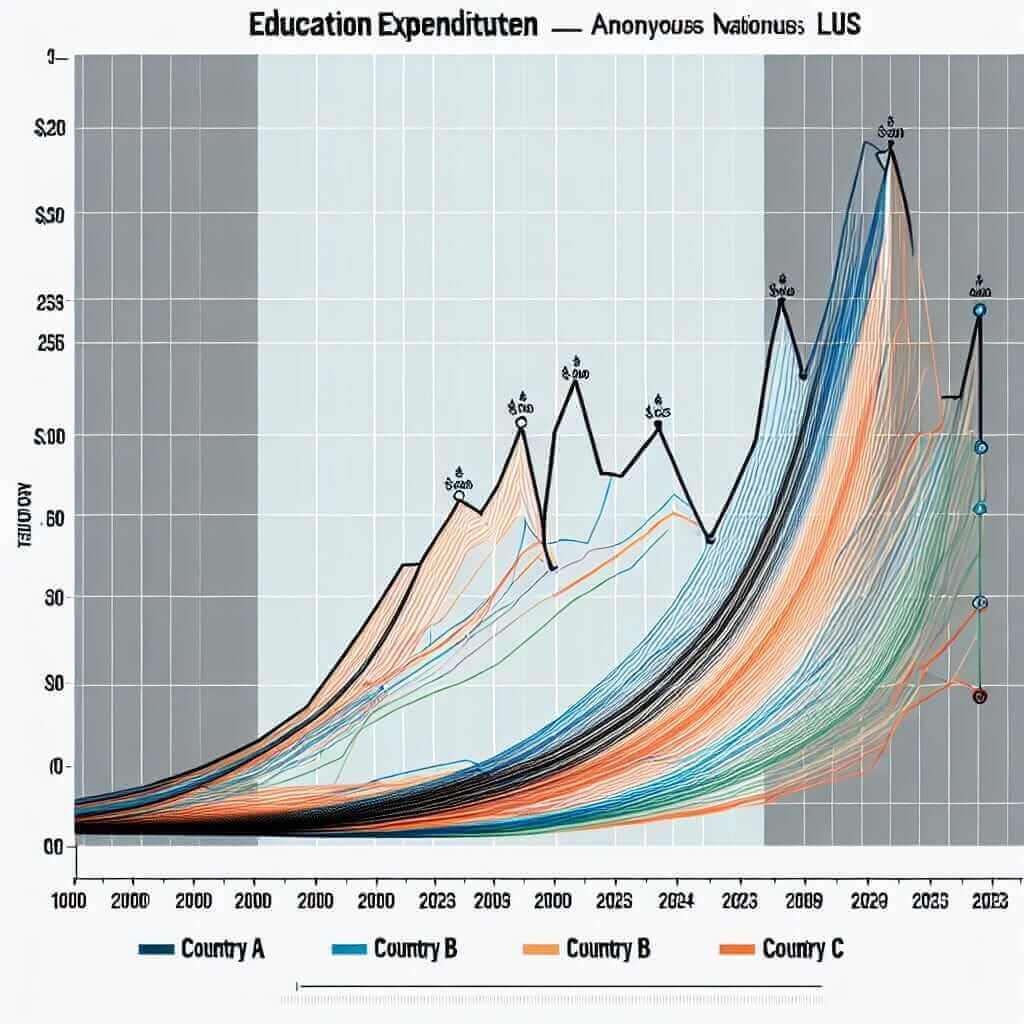When preparing for the IELTS Writing Task 1, one of the common types of questions you may encounter is a comparative analysis task involving statistical data, such as comparing education spending across different countries over a period. This topic not only evaluates your ability to interpret data but also your skill in presenting this information coherently.
Examining the Topic and Its Importance
Comparing education spending in different countries from 2000 to 2023 is a relevant topic given the global focus on education’s role in a nation’s development. This type of comparative analysis frequently appears in IELTS Writing Task 1 and requires a clear understanding of trends and variations over time.
Potential IELTS Writing Task 1 Prompts:
- Compare the levels of education spending in Country A, Country B, and Country C from 2000 to 2023.
- Describe the changes in education expenditure in different regions over the past two decades.
- Analyze the education spending trends of five different countries between 2000 and 2023.
For this article, let’s choose the first prompt to create a comprehensive analysis:
Sample Prompt:
“Compare the levels of education spending in Country A, Country B, and Country C from 2000 to 2023.”
Gathering and Presenting Data
Table of Education Spending (2000-2023)
Here’s a hypothetical dataset representing the education spending (in billion USD) across the three countries from 2000 to 2023.
| Year | Country A | Country B | Country C |
|---|---|---|---|
| 2000 | 10 | 15 | 12 |
| 2005 | 12 | 18 | 14 |
| 2010 | 14 | 20 | 16 |
| 2015 | 18 | 22 | 19 |
| 2020 | 20 | 25 | 22 |
| 2023 | 23 | 27 | 24 |

Analyzing the Data
From the table, each country demonstrates an increase in education spending over the 23-year period. Notably:
- Country A exhibits a gradual increase from 10 billion USD in 2000 to 23 billion USD in 2023.
- Country B shows steady and slightly higher spending, starting at 15 billion USD in 2000 and reaching 27 billion USD in 2023.
- Country C follows a similar upward trend from 12 billion USD in 2000 to 24 billion USD in 2023.
Writing the Analysis
Introduction
When comparing education spending across different countries, it is essential to present a structured and clear overview. Begin with a brief introduction outlining the purpose of the comparison.
Example:
The table illustrates the education spending in billion dollars by Country A, Country B, and Country C from 2000 to 2023. Overall, all three countries show a consistent increase in their education expenditures over the period.
Body Paragraphs
-
Detailing the Trends:
- Country A: Describe the year-by-year increments and overall percentage increase. Highlight any notable jumps in spending.
- Country B and Country C: Follow the same structure, noting differences and similarities between the countries.
-
Comparative Analysis:
Explain the relative differences between the countries, such as which country spent the most each year and how their spending trajectories differ.
Example:
In 2000, Country A allocated 10 billion USD to education, which rose steadily to 12 billion in 2005, marking a 20% increase. By 2023, spending had more than doubled to 23 billion USD.
Country B started with a higher expenditure of 15 billion USD in 2000. It saw a consistent increase, reaching 18 billion in 2005 and culminating at 27 billion in 2023, indicating a significant 80% rise.
Similarly, Country C’s spending increased from 12 billion in 2000 to 24 billion USD in 2023. Despite a slower start, its expenditure grew by 100% over the years, matching the allocation pattern seen in Country A.
Conclusion
Summarize the key findings, highlighting the most significant trends and offering a brief reflection on what these trends might suggest about the educational priorities of the countries.
Example:
In summary, all three countries have significantly increased their education expenditures from 2000 to 2023, with Country B consistently spending more in comparison to the others. The continued rise in spending highlights a shared emphasis on enhancing educational infrastructure and resources over the two decades.
Tips for Writing
Vocabulary and Phrases
- To describe changes: “increase,” “rise,” “grow,” “double,” “climb,” “decline,” “drop”
- To compare: “higher than,” “lower than,” “similar to,” “compared to,” “in contrast to”
- To specify timeframes: “over the period,” “from [year] to [year],” “over the years”
Grammatical Structures
- Comparative and superlative forms: Ensure you correctly use comparative structures (e.g., higher than, more than) and superlative forms (e.g., the highest, the greatest).
- Complex Sentences: Use conjunctions like “while,” “whereas,” and “although” to form complex sentences that compare data points.
Key Vocabulary to Remember
- Expenditure (noun) /ɪkˈspendɪtʃər/: The amount of money spent on a particular purpose.
- Consistent (adjective) /kənˈsɪstənt/: Always behaving or happening in a similar way.
- Trajectory (noun) /trəˈdʒektəri/: The path followed by an object or trend.
- Allocation (noun) /ˌæləˈkeɪʃən/: The process of distributing resources for a particular purpose.
- Enhance (verb) /ɪnˈhæns/: To improve the quality or value of something.
Conclusion
For a successful IELTS Writing Task 1 essay on comparing education spending, focus on presenting clear trends, utilizing comparative language effectively, and structuring your essay logically. Aim for coherence and cohesion throughout your writing to achieve a Band 7 or higher.